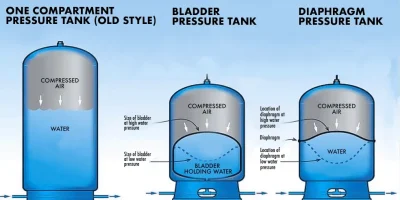
A pressure tank is essential to keeping your well in working order. By keeping the well pump from turning on and off quickly and maintaining water pressure throughout your home, pressurised well tanks increase the life of your well pump. Your household’s water needs will be covered and your pump will be safeguarded from short-cycling with an appropriately sized pressure tank.
Join John Woodard, our Master Water Specialist, as he discusses well pressure tanks, including what they are, how to size them, and what extras you require to ensure proper operation.
A well pressure tank: what is it?
A well pressure tank keeps the home’s water pressure constant, but more crucially, it extends the well pump’s life. Water is required from your well each time a tap is opened, a toilet is flushed or a bath is run. Before asking the well pump to turn on, the pressure tank has enough water to fill these demands. This prolongs the interval between the pump’s activation and deactivation. If the on/off cycle is quick, the pump will activate each time you open a tap and shut off when you close it.
A pressure tank protects your well pump by lengthening the time between the on and off cycles, preventing accelerated wear and tear. Additionally, it regulates the water pressure in your entire home, preventing your faucets from spitting and sputtering while they wait for the pump to catch up.
What’s the process of a well pressure tank?
Compressed air is used by a well pressure tank to force pressurised water out of the tank and into your house. A diaphragm, also known as a bladder, is used in pressure tanks to divide the water from the air chamber. The air chamber is compressed while the tank is filled with water. Compressed air pressurises the water and forces it back out of the tank when you turn on your water.
How does a well pump pressure switch operate?
Pressure switches and pressure tanks are designed to work together. The pressure switch keeps an eye on the tank’s pressure. Based on the increase and decrease in tank pressure, it tells the well pump when to run and when to stop. The majority of homes are configured to use a pressure switch that activates the pump at 30 pounds of pressure and deactivates it at 50 pounds of pressure. When the tank’s gauge shows that the maximum pressure has been reached, the switch automatically turns the pump off.
What is drawdown in a pressure tank?
The amount of usable water in the pressure tank is known as drawdown. It is the amount of water removed from the tank in the interval between the on and off times of the pump. The tank’s pressure drops when water is released from it. If a 30/50 pressure switch is being used, the pressure will gradually decrease until it hits 30 psi. As soon as the tank hits 50 psi, the pressure switch will turn on and start the well pump. The drawdown is the amount of water between 50 and 30 psi. The drawdown essentially refers to the amount of time the pump is shielded from turning on and off.
How should a well pressure tank be sized?
Knowing the flow rate, the pump’s minimum runtime, and the pressure switch setting are necessary for the three steps involved in sizing a well pressure tank. To determine what size pressure tank is appropriate for a system, all three variables must be combined in a calculation. To correctly size your well pressure tank, follow these steps:
The flow rate
Your pump’s flow rate is expressed in gallons per minute.
Shortest Runtime
You can calculate the drawdown capacity by multiplying the flow rate by the pump’s shortest possible runtime. Any pump that is working at 10 gallons per minute (GPM) or below should be producing one gallon each minute of runtime, according to the general rule of thumb.
(For example, 10 GPM flow rate x 1 = 10 gallon drawdown capacity.)
Anything above 10 GPM should be producing 1.5 gallons per minute of runtime.
(For example, 16 GPM flow rate x 1.5 = 24 gallon drawdown capacity.)
If your flow rate is above 20, you may require multiple tanks.
- Setting the pressure switch
The pressure switch setting determines when the pump starts to fill the tank and when it shuts off once it realises the tank is full. 20/40, 30/50, and 40/60 are the three pressure switch settings for pressure tanks. The pressure at which your pump switches back on is represented by the first number, and the pressure at which it goes off is represented by the second number (for example, 20 psi on, 40 psi off). Your drawdown capacity will be most directly impacted by the setting that shuts off the pump pressure. For instance, the drawdown capacity on a 40/60 switch will be lower than it would be on a 30/50 switch.
A tank bundle is what?
It is crucial to get a matching tank package, commonly known as a t-pack, when buying a new pressure tank. The t-pack will fasten to the well tank’s outlet before connecting to your home’s intake line at the wall. Many of the components you’ll need to run and keep an eye on your well pressure tank are included in these, including the pressure switch, pressure gauge, relief valve, tank cross, and ball valve.

